
Kashgar to Aksay Qin
Kashgar
,
Xinjiang
-
China
|
|
Where do I begin?
With the remoteness, the scale, the altitude? How about with a joke! A guy decided to get away from it all and moved to a remote cabin. He had barely unpacked when someone was knocking at his door. "Howdy neighbor," said the visitor, "I stopped by to invite you to a party." "No thanks." said the newcomer. The visitor insisted, "Are you sure?" "There should be plenty of drinking and fighting and fucking!" The newcomer thought for a moment, "Well, I guess it would be good to meet my neighbors. What does a fella have to wear to one of these parties?" The visitor replied "Nothing special, it's just going to be you and me." If getting stuck for days, snapping tow cables and breaking leaf springs is your kind of fun, western Tibet is the place for you. * * *
Lonely Planet decrit cette region comme etant la plus reculee du monde. En effet, c'est probablement le seul endroit ou je n'ai pu entendre Celine Dion chanter, sentir les ondes d'un televiseur ou simplement utiliser des toilettes. Si de rester pris dans la boue pendant des jours,
d' assister au bris d'essieux et de pousser des camions de plus de 14 tonnes vous fait vibrer, alors le Tibet occidental vous attend.
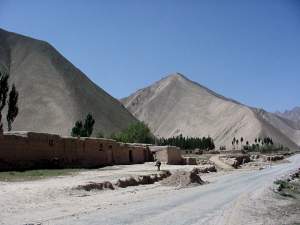
|
Leaving Kashgar
From Kashgar we took a public bus that headed east along the southern edge of the huge Talimakan "If you go in you don't come out" Desert. 120 Km later we arrived in Yecheng where we spent the night. In the morning we took a taxi further down to a turn off where highway 219 started. This road drops south from the desert and goes straight up into the arid mountains that form the far western edge of the Tibetan plateau. The kilometer marker showed 0. We would follow this road 1050 kilometers all the way to Ali, were we would then regroup for our effort to get to Mount Kailash, our main objective. We were poised for adventure with warm clothes, a tent, 6 liters of water and over 20 Kg of food. * * *
On a pris un autobus jusqu'au village de Yecheng, situe a 6 km de l'autoroute 219 qui mene au plateau Tibetain. Cette autoroute part de 1000 metres d'altitude dans l'immense Talimank desert chinois et grimpe plus de 4000 metres avant de finalement traverser la frontiere Tibetaine. On avait 1050 km de gravelles devant nous avant d'atteindre Ali, la ville Tibetaine la plus occidentale. De la nous aurions a nous rendre au Mont-Kailash, notre objectif principal.

|
We hitched a couple short rides and spent the next night under the stars at a cluster of simple homes called Akmequit on our map. The next morning we flagged down two trucks going all the way to Ali, the Gods were smiling. There were a total of 3 drivers and they already had 2 passengers: a quiet Japanese fellow and a sickly Muslim mystic. Neither had brought any food or shelter. * * *
Notre premiere journee a faire du pouce ne fut pas un grand succes. Nous avons donc du dormir dans un petit village a 50 km d'ou nous etions partis. Le second jour par contre nous a souri. Deux camions en direction d'Ali etaient pres, pour une petite fortune $60.00(US) chacun a nous y enmener. Il faut comprendre que c'est illegal selon la loi chinoise, pour des touristes d'emprunter cette route. Cette situation rend nos camionneurs passibles d'amende. Les Uyghurs (nos conducteurs) n'aiment pas leurs envahisseurs Chinois au point d'en faire une histoire
d'amour de les hair. Ils en font de meme de leurs lois restraignantes et controlantes.
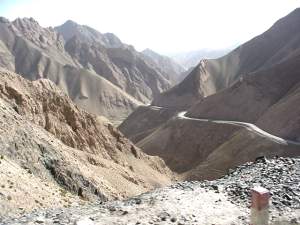
|
The road immediately started to ascend into foreboding mountains. They were bone dry and nearly barren of vegetation. Suffocating dust often swirled around the trucks. In fact there was a pall of dust that covered the entire region, all but obscuring the snow covered peaks in the distance. * * *
Un paysage tres aride faisait place a d'arides montagnes dont les sommets etaient soupoudres d'une neige fine.
A lot of work and resources had been put into highway 219. Many sections still remained intact and provided smooth sailing. But a wet winter had laid waste to most of it. Hundreds of kilometers of road and telephone poles had been swept aside. * * *
Cette autoroute requiert de constantes reparations. Les hivers enneiges et les etes pluvieux on tendance a effacer les efforts precedents. Plusieurs poteaux electriques ne donnaient plus signe de vie.
Along the rivers the truckers either crept along precarious ledges of the once glorious 219 or forged new routes in the riverbed. * * *
Les camions parcouraient des escarpements le long des rivieres qui parfois nous faisaient frissoner.
All the truckers had stashes of bread and melons that made for impromptu meals. We would bring out our bags of dried fruit and nuts to add to the feast. The melons provided much-needed hydration in this arid land. * * *
La route etant difficile, de nombreuses pauses caf®¶ devenaient necessaires pour nos chauffeurs. Des petites montagnes de melons et de nan(pain Uyghur) qu'ils transportaient, les maintenaient jusqu'au prochain rassemblement de Shack-Restos.
Uyghur Families
The few bands of vegetation were settled and cultivated by Urghur families. * * *
Le peu de verdure etait cultivee par quelques familles Uyghurs.
The truckers knew one of the families and we stopped by for some chai (tea) and yogurt. Hospitality is part of the Muslim culture. * * *
L'un des hommes a bord connaissait cette famille. Ils en ont profite pour y laisser quelques melons. On y fut servi comme des rois avec du chai, pain de mais(inmangeable) et yogurt. Il nous est apparu que plusieurs dames se partageaient le meme homme. Un appercu de la vie nomadique Uyghur.

Xaidulla
|
Lunch Time
Little towns, or outposts, appeared every hundred kilometers or so. We could get hot meals and the truckers could get their flats fixed and other minor repairs. * * *
De petits postes militaires situes ici et la nous permettaient de manger et nos vehicules de se faire reparer.
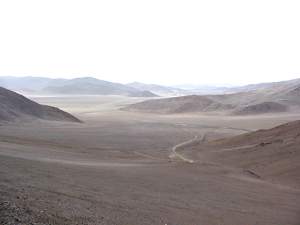
Looking down into the Aksay Qin
|
Aksay Qin
On our second day with the trucks we crossed a 5400-meter pass into the Aksay Qin. This area is actually part of northern Kashmir and even the valleys were above 5000 meters. China took military possession of this land from India about 40 years ago. It is still a sore point diplomatically. * * *
Au troisieme jour, nous avons franchi un col de 5100 metres qui nous a mene a Aksai Qin. Ce territoire fait parti du Nord du Kasmir. La Chine en a pris possession militaire il y a quarante ans, ce que l'Inde continue de contester jusqu'a aujourd'hui.
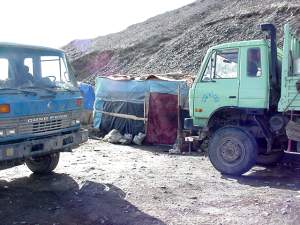
Mutton and Noodle Soup at 5100 Meters
|
Most roadside services disappeared entirely except for rough and ready Urghur restaurants. We would all pile into these tarp and plywood shacks for hearty bowls of hot mutton and noodle soup. The Urghurs still have a tribal feel to their society. We would kick off our shoes and install ourselves on several beds squeezed around a single table. In the kitchen a dressed out sheep would be hanging from the ceiling. The cook would shack off an appropriately sized shank and then make up some doughy noodles. The whole process would take a few hours, but amidst all the chai and tall tales of life on the road in western Tibet, nobody seemed to care. * * *
A partir de ce point tout poste militaire a disparu pour laisser place a de veritables Shacks fait de scraps de metal et de bashs bleues ou l'on servait le fameux langman Uyghur. C'est une soupe faite de nouilles et de viande de mouton servi avec une sauce tomate un peu epicee. Dans ces cabanes, on empile une quinzaine d'hommes affames que l'ont fait attendre des heures pour leur langman. Ils profitent de cette attente pour raconter leurs plus recents exploits, rire des mesaventures qu'ils ont du traverser et prouver leur masculinite au pres de leurs collegues. Une pause bien meritee pour moi, la seule femme du convoi.
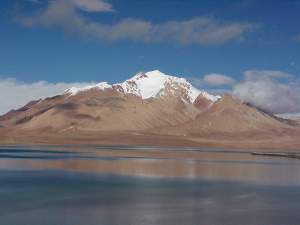
The Lake at Sumxi
|
The trucks travel in convoys to ensure their safe passage. Everybody carries a variety of spare parts and chances are good that if you donít have the parts for a minor repair, your buddies might. By the end of our trip all the spare tires except one had been used and all the tow cables had been snapped. * * *
Les camions voyagent en froupe afin de pouvoir
s'entraider, si quelque chose tournait mal. Tous et chacun en possession d'outils divers et de morceaux de rechange. La nature de la route qu'ils parcourent les oblige a devenir des mechaniciens avertis.
Most of these trucks had American Cummins 5.9 liter diesel engines and double tanks with around 300 liter total capacity. In addition they all carried at least three 200 liter barrels of additional diesel as there were no gas stations along this 1000 Km highway. Our convoy started as two, soon became three and now stood as five. We were to find out later that larger convoys meant worse terrain. Our truckers had been talking to rigs coming from the other direction and the reports werenít good. * * *
Nous avons commence ce periple avec un convoi de deux camions qui s'est vite vu augmente a cinq. Un signe que les conditions de la route allaient de mal en pire.
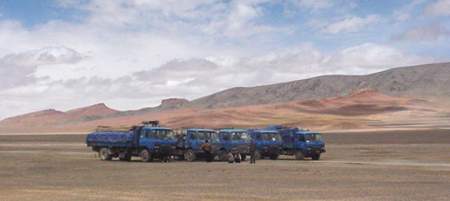
Safety in Numbers
|

|